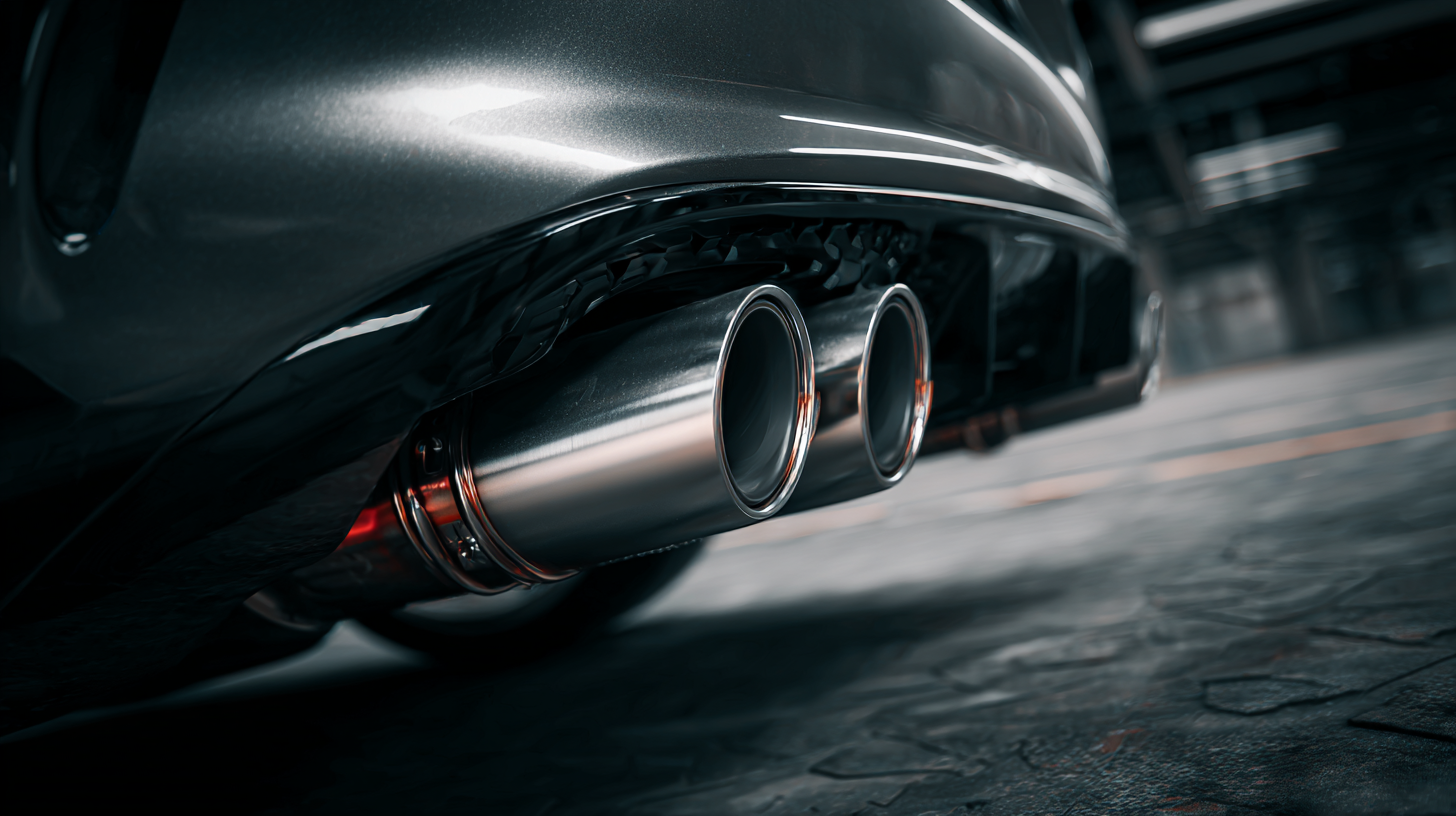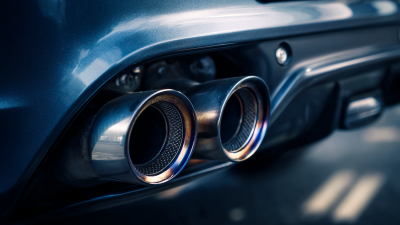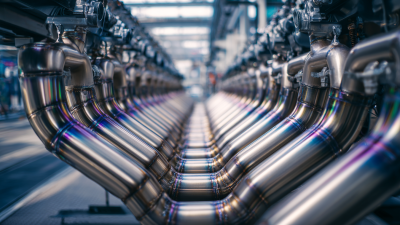10 Essential Tips for Choosing the Right Muffler Straight Pipe for Your Vehicle
When it comes to upgrading your vehicle's exhaust system, choosing the right Muffler Straight Pipe can make a significant difference in performance, sound, and efficiency. As expert automotive technician John Smith noted, “Selecting the proper muffler straight pipe not only enhances your vehicle's horsepower but also provides a unique exhaust tone that defines its character.” With a myriad of options available on the market, determining the best fit for your car can be a daunting task.

In this guide, we will explore ten essential tips that will help you navigate the complexities of selecting a Muffler Straight Pipe tailored to your specific needs and preferences. Whether you are an automotive enthusiast looking to make a bold statement or a driver seeking improved functionality, understanding the key factors in choosing the right straight pipe is crucial. From material choices to design specifications and compatibility with your vehicle, this comprehensive list of considerations will equip you with the knowledge necessary to make an informed decision that enhances both performance and aesthetics.
Understanding Muffler and Straight Pipe Basics for Your Vehicle
When considering mufflers and straight pipes for your vehicle, it's essential to understand the basics of how these components function within your exhaust system. Mufflers are designed primarily to reduce noise, while straight pipes enhance the flow of exhaust gases, improving performance and sound. This relationship between mufflers and straight pipes can significantly affect your vehicle's overall efficiency.
One of the first tips for choosing the right muffler straight pipe is to consider your vehicle's specific needs. Analyze factors such as engine size, type of driving, and local regulations on noise emission. A well-tuned exhaust system not only improves horsepower but also ensures compliance with legal standards. Additionally, pay attention to the materials used in the construction of the pipe. Stainless steel options offer durability and resistance to rust, making them ideal for long-term performance.
Another important aspect is to match the muffler with the straight pipe's diameter. Choosing a pipe with the correct diameter helps maintain optimal exhaust flow, enhancing performance without creating back pressure. Lastly, don't forget to check for compatibility with your vehicle's make and model; a fitting that works for one vehicle may not be suitable for another, affecting both performance and sound quality.
Evaluating Material Options: Stainless Steel vs. Aluminized Steel
When choosing the right muffler straight pipe for your vehicle, the material you select can significantly impact performance, durability, and sound. Two popular options are stainless steel and aluminized steel. Stainless steel offers superior corrosion resistance, making it an ideal choice for vehicles exposed to various weather conditions and road salts. It often lasts longer than aluminized steel, which tends to rust and decay more quickly, especially if it's not coated properly. However, stainless steel can be more expensive, so it's essential to weigh your budget against long-term benefits.
Aluminized steel, on the other hand, is a more affordable alternative that can perform well when used in dry conditions. It features a steel core coated with aluminum, providing a level of corrosion resistance but not as robust as stainless steel. If you’re looking for a balance between cost and performance for everyday driving, aluminized steel might fit the bill.
When selecting your muffler straight pipe, consider the following tips: always check compatibility with your vehicle's make and model, evaluate the desired sound level, and confirm the installation process based on the material type. Prioritizing these factors can ensure you make the best choice for your vehicle's needs.
Sizing Considerations: How to Measure for the Perfect Fit
When selecting the right muffler straight pipe for your vehicle, proper sizing is crucial to ensure optimal performance and compatibility. According to a report by the Automotive Aftermarket Suppliers Association (AASA), achieving the correct fit can prevent issues such as exhaust leaks and reduced engine efficiency, both of which can significantly impact performance. To measure for the perfect fit, start by determining the diameter of the existing exhaust system. Most vehicle exhaust systems range from 2 to 3 inches in diameter, but performance modifications can lead to variations. Using a caliper to measure the outer diameter of the pipe will provide an accurate measurement.
In addition to diameter, it's essential to consider the length of the straight pipe. A study published in the Journal of Automotive Engineering found that even minor differences in length can affect back pressure and, subsequently, engine performance. Measure the distance from the inlet to where the exhaust system terminates, ensuring that your new straight pipe matches this measurement. Many manufacturers provide additional sizing tools and guides which can be helpful during the selection process. By taking the time to accurately measure and consider these factors, vehicle owners can enhance their vehicle's performance while avoiding costly modifications down the line.
10 Essential Tips for Choosing the Right Muffler Straight Pipe for Your Vehicle - Sizing Considerations: How to Measure for the Perfect Fit
| Tip |
Description |
Measurement Required |
Typical Diameter (inches) |
| 1. Know Your Vehicle |
Check the make and model specifics. |
Vehicle model year & type |
2.5 - 3.0 |
| 2. Measure Existing Pipe |
Use calipers to measure width. |
Outside diameter |
2.5 - 4.0 |
| 3. Consider Muffler Design |
Different designs affect performance. |
Type of existing muffler |
Varies |
| 4. Assess Your Sound Preference |
Different pipes generate different sounds. |
Sound preference |
N/A |
| 5. Look at Material Options |
Stainless steel vs. mild steel. |
Material choice |
N/A |
| 6. Check Compatibility |
Ensure fit with exhaust system. |
Compatibility check |
N/A |
| 7. Review Installation Options |
Evaluate DIY vs professional installation. |
Installation type |
N/A |
| 8. Check Local Regulations |
Ensure compliance with noise laws. |
Local laws |
N/A |
| 9. Budget for Expenses |
Price of parts and labor. |
Estimated costs |
N/A |
| 10. Read Reviews |
Customer feedback on products. |
Research findings |
N/A |
Performance Benefits: Choosing a Muffler for Sound and Efficiency
When it comes to enhancing your vehicle's performance, selecting the right
muffler straight pipe is crucial for achieving the desired sound and efficiency. A well-chosen muffler can significantly impact both the auditory experience and power output of your car.
High-performance mufflers often emphasize a deeper, more aggressive sound, which not only gives your vehicle a sportier edge but also helps in relieving back pressure.
This enhanced exhaust flow allows the engine to operate more efficiently, promoting better fuel economy and overall performance.

Moreover, the material and design of the muffler play vital roles in determining the sound profile and efficiency levels.
Stainless steel options offer durability and resistance to corrosion, resulting in a longer lifespan and maintaining optimal sound quality.
Additionally, consider the diameter of the pipe; a wider diameter generally supports better exhaust flow, which can lead to improvements in horsepower.
By incorporating these elements, you can fine-tune your vehicle's exhaust system to elevate both its sound signature and performance, ensuring that every drive is as exhilarating as it is efficient.
Installation Tips: DIY vs. Professional Help for Muffler Replacement
When considering a muffler replacement, one of the primary decisions you'll face is whether to tackle the installation yourself or hire a professional. Opting for a DIY installation can be an appealing choice for those who enjoy working on their vehicles and have some mechanical aptitude. With the proper tools, a clear understanding of your vehicle's exhaust system, and a reliable guide, you can successfully install a straight pipe muffler. However, this route requires time and patience, as any mistakes could lead to further repairs or safety issues.
On the other hand, enlisting a professional mechanic offers peace of mind, as these specialists have the expertise and experience to ensure a proper installation. They can quickly diagnose any underlying issues, perform the installation efficiently, and provide warranties on their work. While this option may come with a higher cost, the benefits of guaranteed quality and safety make it a worthwhile consideration for many vehicle owners. Ultimately, the choice between DIY and professional help should align with your comfort level, skills, and the complexity of the muffler replacement task.
Comparison of DIY vs. Professional Muffler Replacement Costs
 +86 17870576410
+86 17870576410

Home
Company Profile
Products
News
Blog
Contact Us
 Contact Number
Contact Number







